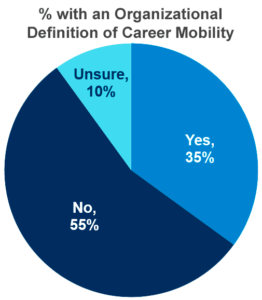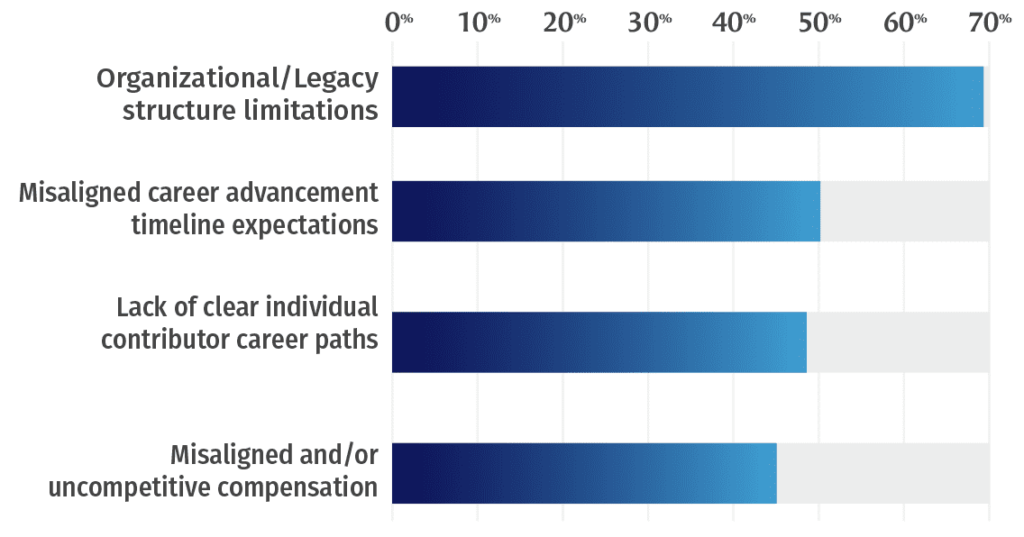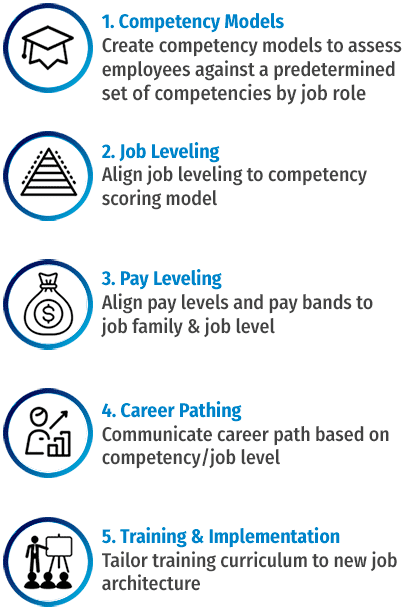Winning Strategies for Career Mobility
The race for talent is real, but a winning strategy doesn’t have to be out of reach.
Career mobility is no longer just climbing the corporate ladder. To succeed, organizations must embrace new strategies that address the shifting demands of employees who want more than just better pay but also desire a path for advancement and fulfillment.
What is Career Mobility?
The recent great reshuffle reveals that employees are no longer waiting for their employer to define their career path. For example, recent Alexander Group research indicates that while media firms experienced a 20% turnover on average, a third (33%) of employees did not look within their firm for new opportunities according to Harvard Business Review. These sharp statistics demonstrate that companies need a clear action plan to win and equally participate in the race for talent.
Today’s career mobility is more than just moving from one position to another over the course of time. Instead, mobility is a thoughtful approach, including job design, competencies, career pathways and training, that combine to become more than the sum of the parts. Simultaneously, employers must demonstrate inclusive values while being transparent about their actions. It is a tall order for today’s media organizations, and they must work quickly to implement a holistic career mobility approach that solves today’s problems and paves the way for the future.
Gaps and Roadblocks of Traditional Career Strategies
Companies now face astronomical recruitment and training costs, with 5% of jobs still unfilled. Where’s the gap?
Employees expect straightforward career mobility and advancement pathways. Employers are expected to provide comprehensive, forward-thinking, equitable career growth options that meet the ever-changing values of their diverse workforce. As both individuals and companies scramble to keep up with volatile economic conditions, how can these two desires be aligned so that both parties have long-term success?

Leading media firms are switching from a reactive hiring and mobility approach to a proactive, holistic strategy that benefits both the organization and the employee. As an initial step, firms are trying to create a strategic advantage by incorporating:
- Detailed job profiles that outline performance, competency and development expectations
- Recognition programs
- Defined paths (sometimes non-linear) for career growth
But are these traditional elements enough to create a strategic advantage? One issue is that career mobility looks different in every organization. Alexander Group’s research indicates that only 35%, of companies have a clear definition of “career mobility,” while the other 65% have an unclear or no description and 71% of media leaders are unsure if their career mobility strategy is competitive. As a result, managers continually fight to keep employees from jumping ship while searching for new people to fill already empty seats.
Frontline Talent Issues
Are there specific roadblocks that inhibit career mobility planning? In a recent Alexander Group Media roundtable, we polled participants about their top career mobility pain points:

Media companies confront significant obstacles, including cultural issues that strain front-line leaders and stunt training and development. In addition, employees now evaluate their jobs under a new lens, being sensitive to inconsistent workloads, inflexible work models and lack of new career paths. Finally, compensation is also an issue for sales professionals who strain to meet increasing quotas with limited upside and employers who encounter unprecedented inflation in compensation.
Overheard at the recent Alexander Group Media Advisory Council session: Candid challenges discussed by members including:
Unrealistic pay and advancement expectations. Do you promote or give a raise to a relatively new hire just so you can keep them, even though they may not technically qualify for more money or responsibility? Managers are repeatedly challenged to compensate people beyond their pay grade or promote them too quickly to a position they are not ready for, just to keep them on staff.
Mid-level and experience poaching. Experienced employees and trained specialists continue to receive offers from competitors and other industries. So how do we keep them on board today but promise them a path for tomorrow if we don’t have clear advancement opportunities?
Hungry people want development training. If we don’t provide consistent leadership and development training, young “hungry” people will exit. We must offer consistent upward training or we will constantly be giving onboarding training to new hires. We don’t need “training” to be equated with “punishment.” We need to have competency training for people who are ready to accelerate their careers.
The location reality check. Are work routines different across locations? How important are in-person networking opportunities? Setting unrealistic expectations for onsite, hybrid or remote staff can pose a challenge for leadership. Leaders cannot view “work” from one perspective but must incorporate all location perspectives. Creating intentional experiences can connect employees regardless of their location.
Department silos prevent growth. Keeping an employee may require offering them a path to a different department. But if their current department leader does not want to lose the employee, they may not let them leave, aggravating the employee and contributing to talent loss.
These are just a few of the complexities that media firms face. Keeping people on board and engaged is a continual battle but having a plan for success will offer solutions that help both the employee and the media firm reach their goals.
5 Key Elements of a Winning Career Mobility Strategy
Leading media firms are redefining career mobility with a comprehensive look at jobs across all business units using five essential elements.

When combined, these five elements create a clear strategy for career mobility yet do not limit an employee to a specific path. Organizations now recognize that their workforce wants more than the limitations of vertical trajectories but can also benefit from lateral or uniquely crafted moves across the company.
These elements create a dynamic foundation for employees to grow within the organization. Leading media firms revisit these components and update them as cultural, workforce or competitive forces change. In addition, third-party benchmark data pinpoints where competencies, job levels, sales compensation or career paths may be off track, helping companies to pivot to attract and retain talent quickly.
A comprehensive talent approach offers flexibility yet creates a strategic advantage for media firms and employees who want a clear path to success.
Do You Have a Winning Talent Strategy?
The race for talent is real, but a winning strategy doesn’t have to be out of reach. Alexander Group has the market research and competitive insights to show where your talent strategy shines or needs improvement. For more information on how to develop or enhance your career mobility strategy, please contact an Alexander Group Media Practice lead.
| Career Mobility Health Checklist |
|---|
|

